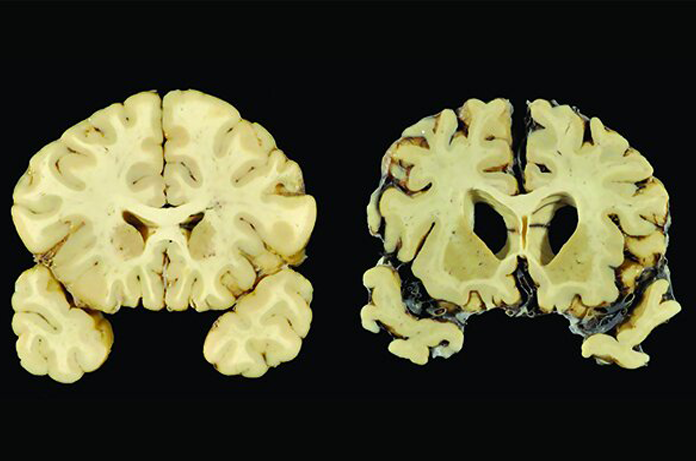
Chronic Traumatic Encephalopathy (CTE) is a progressive degenerative disease of the brain found in people with a history of repetitive brain trauma. CTE affects athletes who participate in sports which expose them to repeated head trauma such as boxing, football, and hockey. Military veterans are also at risk, with military service carrying a high potential for head trauma in many cases.
Football in particular has gained a lot of attention around CTE. “You are supposed to be tough. You are supposed to play through pain. You are not supposed to cry. We are taught that early on in the game as kids. Tough sport. Brutal sport. It’s like being a gladiator. People want to see the big hits. And as a player, you don’t want to admit you are injured.” says Hall of Fame running back Eric Dickerson.
Patients can present with symptoms of CTE many years after head trauma has occurred. This is possible because repeated brain trauma triggers a slow progression of brain tissue degeneration. These changes in the brain can begin months, years, or even decades after the last brain trauma has occurred.
SYMPTOMS OF CTE AND DIAGNOSIS
The symptoms of CTE can mimic dementia, even being called ‘dementia pugilistic’ when it was first discovered. May scientists disagree on the symptoms of CTE and research is still underway, however, the disease has been associated with memory and thinking problems, confusion, personality changes, and/or erratic behavior including aggression, depression, and even suicidal thinking. Other symptoms may include problems paying attention and organizing thoughts as well as difficulty with balance and motor skills.
CTE eludes diagnosis due to symptom overlap with other brain disorders such as Alzheimer’s disease and Parkinson’s disease and also psychiatric disorders such as clinical depression. Because of the commonalities between CTE and these disorders, a CTE diagnosis can only be made after death, when an autopsy can reveal whether the known brain changes of CTE are present. That being said, when CTE is suspected, neurological testing and psychiatric screening can be used to rule out other issues
THE SILENT KILLER
Even when concussions are asymptomatic, they can still contribute to brain degeneration, making CTE a silent killer. The culprit in this degeneration is an abnormal protein call tau. Tau is also associated with dementia, however, research has found that with CTE a unique pattern of abnormal tau is present which builds up in the tissues and around the blood vessels.
“The question is whether, even after they are asymptomatic, players might still be recovering in ways we don’t know much about. It has shown that up to 3 or 4 weeks after concussion and the disappearance of symptoms, there are subtle differences in brain activity—suggesting recovery may not be complete. This is the stuff that nags at any doctor making return-to-play decisions.” says Dr. Robert Cantu, Professor of Neurosurgery at Boston University Medical School and Co-Director of the Center for the Study of Traumatic Encephalopathy (CTE).
THE SCIENCE BEHIND THE PATHOLOGY
To understand the science behind CTE, you first need to understand its different stages. In stage one, symptoms are fairly mild and can include headaches as well as loss of attention and concentration. The physical characteristics of a brain with stage one CTE are unremarkable and sometimes nonexistent — approximately one-half of brains with stage one CTE show visible pathology. When present, they are only microscopically detectable and most commonly localized to the frontal, temporal, insular, septal, and parietal areas of the brain.
In stage two, CTE can present with symptoms of depression or mood swings, explosively and short-term memory loss, in addition to stage one symptoms. Less common stage two symptoms can include executive dysfunction, language difficulties, and impulsivity. The physical characteristics of a brain with stage two CTE are more prominent than in stage one and include mind enlargement of the frontal ventricles as well as other areas of the brain. In addition, detectable levels of tau protein are present in the frontal and temporal areas of the brain. Also present in the brain are pre-neurofibrillary tangles (NFTs) which are aggregates of tau protein.
In stages three and four, the most advanced stages of CTE, patients exhibit all of the symptoms of the first two stages however the severity of symptoms is drastically increased. At stage three 75% of patients are considered cognitively impaired. At stage four, researchers found that most patients developed a profound loss of attention and concentration, executive dysfunction, language difficulties, explosivity, aggressive tendencies, paranoia, depression, gait, and visuospatial difficulties.
Studies of patients in stage four also site that the most common causes of death for those with CTE are respiratory failure, cardiac disease, suicide, overdose, and symptoms associated with end-stage dementia and malignancy.
In the latter stages of CTE, the brain shows macroscopic changes with structural changes becoming evident in stage four. In the final stage of CTE, there is a reduction in brain weight, mild frontal and temporal atrophy, and enlargement of the lateral and third ventricles. The presence of NFTs becomes prevalent as well, showing up both superficially and deep within the brain. In short, the entire brain becomes overtaken with pathology.
RESEARCH AND TREATMENT
Millions of dollars are being invested in CTE research by organizations such as the National Institute of Neurological Disorders and Stroke and Brain Injury Research Institute and the Alzheimer’s Association. As a result, better imaging techniques are becoming available and there is hope that in the future CTE will be diagnosable before death. This will inevitably bring forth treatment options for patients suffering from CTE. There is currently no cure or treatment for the disease which makes this research very important for the numerous people suffering from the disease’s effects.